CAP, the automotive information solutions company, believes the consistently strong retail performance of this year’s market is notable. This is despite 2007 kicking off with a smaller January rise in trade values than formerly seen in the trade market at the start of the year. Now, all indicators suggest a stronger trade and retail market in Q1 than the same period in 2006.
Research by CAP has revealed that the once traditional January rise in used values is now muted because dealer behaviour has changed.
“For many years dealers tended to liquidate their stock during November and December in order to convert their assets into cash for accounting purposes. This would depress used values in November and December as supply overtook demand, due to the influx of liquidated stock into the open market.
“Dealers would then follow this period with a surge in trade buying activity to replenish forecourts in January. This historically created a clamour of renewed demand, pushing values back up,” said CAP.
But CAP believes this ‘bust and boom’ cycle has been flattening out in recent times. It means values are no longer dramatically reducing at the end of the year – effectively ironing out the factor that once led to a traditional January ‘recovery’.
CAP also identified that superminis are currently enjoying the biggest surge in values with a representative sample of models demonstrating an average 5.7% increase in trade price. CAP singled out the Nissan Micra 1.4 petrol and both diesel and petrol variants of Vauxhall Corsa as particularly strong performers.
The weakest trade price growth is identified among 4x4s. Again, despite claims that taxation, anti-congestion measures and growing media hostility toward the ‘toff roader’ image are taking a toll on values, in reality CAP says large four-wheel-drive cars have become a victim of their own success.
With the massive increase in registrations and a plethora of new models in recent times, supply has increased ahead of demand in the used market.
“This has led to weakening prices but there are no signs of the British love affair with 4x4s ending anytime soon,” said CAP.
Similarly, the usual spring-time surge in convertible car values has been markedly slower and smaller this year. Research is ongoing into any specific factors which may have contributed to this but CAP experts suggest that again it is the success of the sector, rather than any specific negative factor, which is leading to values levelling off. For example, many would-be buyers of large used convertibles now have the option of choosing from an increasingly wide range of affordable new cars. The last year alone has brought a large number of new choices, including Volkswagen Eos, Vauxhall Astra Twin-Top, a new hard top Mazda MX-5, Ford Focus CC, Mitsubishi Colt CZC and Nissan Micra C+C.
With such a large growth in choice – both between brands and individual cars in an increasingly high volume market – the convertible sector may well now be simply stabilising. The growth of the hard-top convertible is also expected by CAP to encourage less volatility in trade values as they sidestep perceived potential problems around draughts and leaks sometimes suffered by the traditional soft-top during the wettest, coldest months. This new breed of ‘tin top’ is likely to encourage convertible demand all year round and gradually smooth out the former seasonal fluctuations in retail buying patterns for open cars.












Login to comment
Comments
No comments have been made yet.